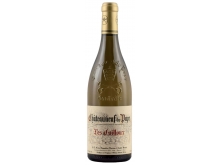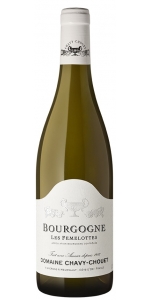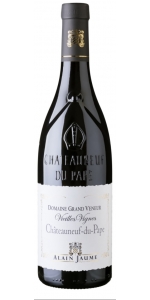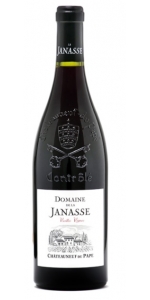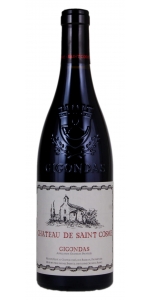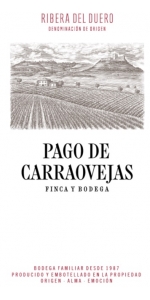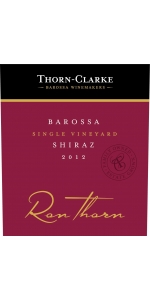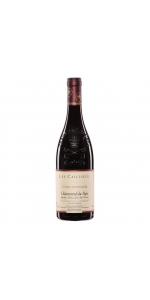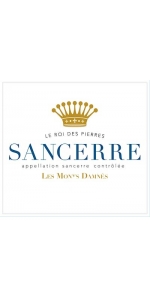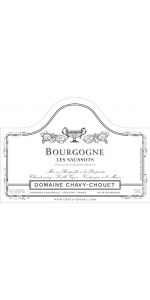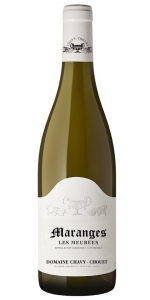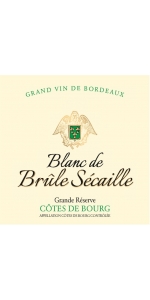Les Cailloux Blanc displays a pale gold color in its youth and evolves into deep gold after a few years of aging. It has floral scents of honeysuckle and jasmine with hints of honey. On the palate, white flowers and honey are joined by minerality and viscosity on the finish. The wine’s surprising complexity grows more well-rounded as it evolves in the glass.
Lucien et Andre Brunel Chateauneuf-du-Pape Les Cailloux Blanc 2021
6 bottles with free shipping for: $420.00
12 bottles with free shipping for: $780.00
| BUY MORE! SAVE MORE! | ||||||||||||||||||||
|
| Country: | France |
| Regions: | Rhone Chateauneuf du Pape |
| Winery: | André Brunel |
| Grape Type: | Roussanne |
| Organic: | Yes |
| Vintage: | 2021 |
| Bottle Size: | 750 ml |
Lucien et Andre Brunel Chateauneuf-du-Pape Les Cailloux Blanc is made from 70% Roussanne, 20% Grenache Blanc, 10% Clairette.
This historic estate was established in the 17th century when André Brunel’s family purchased a vineyard plot from the Bishop of Avignon. André took over the reins of this estate in 1971, and later his son Fabrice joined the winemaking team in 2012, keeping the family legacy alive by pursuing quality with the highest regard and respect for the environment.
Châteauneuf-du-Pape is notorious for its large, round pebbles that absorb the sun’s energy, radiating warmth throughout the night, allowing the grapes to achieve ideal ripeness and incredible complexity. “Les Cailloux” gets its name from the pebbles.
Review:
Inviting aromas of grapefruit and lime zest, Meyer lemon and honeydew harmonize with wild white flowers and stone on the nose. The palate is refreshed by brisk acidity, making way for a wave of fresh pears lemon zest, subtly framed by a layer of stone and light oak spice.
-Wine Enthusiast 96 Points
Our family has been in the Châteauneuf-du-Pape region since the 18th century and has been fully committed to making wine for five generations.
As of the 18th century, the wine-making activity of our family was testified by the purchase of a vineyard plot from the Bishop of Avignon to the north of the appellation.
Numerous generations followed on, all working in the vineyards but it was only in 1954 that Lucien Brunel created the name “Les Cailloux” to develop the business and promote the Domaine’s wine qualities and special characteristics. From that time one, it was referred to as the Domaine Les Cailloux.
In 1971, André Brunel took over the reins of the Domaine. His endless motivation resulted in a rapid growth for the Domaine: repurchasing of Côtes du Rhône and Vins de Pays vines, and launch of the infamous Centenary Cuvée in 1989. He also made some considerable changes in the vine management process by being one of the first people in Châteauneuf-du-Pape to use the ground covering method and to proceed with a non-chemical approach to wine-farming.
In 2012, his son, Fabrice Brunel, joined the team so the family history can continue.
The Estate is divided up into three appellations: Châteauneuf-du-Pape of course, but also Côtes du Rhône and Vaucluse Vins de Pays.
Our pursuit for quality, our utmost respect for the land and the drive to always provide our customers with wines they can enjoy throughout their ageing, impels us to be immeasurably meticulous during its production, regardless its appellation.
The differences are mainly the maturing times (longer for the Châteauneuf, and shorter for the Vins de Pays to make them available sooner) and the usage of vats (for Syrahs in Châteauneuf-du-Pape to mellow out the tannins, absent on the Côtes du Rhône and the Vins de Pays to maintain the fruits freshness).
We want to produce wines reflecting their region and origin while remaining elegant and wonderfully subtle.
Châteauneuf-du-Pape
The Domaine boasts 21 hectares under the Châteauneuf-du-Pape appellation, including 2 with whites, which are divided up into about ten segments. The largest are Farguerol to the north, Revès and Plan du Rhône to the south and Bois de la Ville at the top end of the village.
The soils vary with countless round pebbles but also sandy and clayey soils.
Ground topography: analysis of a segment with round pebbles
The “useful” layers for the vineyard are in tiers of about 3 metres:
- From 0 to 50 cm: mainly pebbles (80%) completed by sand. Large amount of roots.
- From 50 to 140 cm: large amount of pebbles (60%), the rest being mostly clay. A lot of fine roots and rootlets.
- From 140 to 300 cm: layer of accumulated clay but still with pebbles (about 20%).
Deep roots make it easier to trap water which is present over 2 metres under the surface and the pebbles reduce the evaporation due to heat or the Mistral. Therefore the plant is well hydrated even during hot summer weather.
Grape Varieties planted
The red grape varieties are mainly Grenache Noir, followed by Mourvèdre, Syrah and Cinsault:
- 70% of Grenaches, which, if harvested when very ripe, contribute to the strength, roundness and aromas of crushed red fruits,
- 17% of Mourvèdres which, planted in suitable soil (sandy clay) and harvested late, contribute to the structure of lively tannins, emphasizing the qualities of Grenache without making them denatured,
- 10% of Syrah which gives aromas of fresh black fruits and for amplified the colour,
- 3% of Cinsaults which gives a bit of lightness to the whole.
In white grapes, Roussanne dominates (85%) followed by White Grenache (15%).
Chavy-Chouet Bourgogne Blanc Femelottes is made form 100 percent Chardonnay.
This is a charming, rich, focused and delightful white. Medium-bodied with a smooth texture, the wine has a fresh backbone of acidity, clean apple and citrus flavors, and an excellent balance. A most refreshing quaff and one that is great value. A delicate, expressive wine of exceptional quality.
The grapes from this wine are grown from the Puligny-Montrachet area. (either outside of the AOC limit or with younger vines).
The grapes from this wine are grown from the Puligny-Montrachet area. (either outside of the AOC limit or with younger vines).
Aged 10 months in oak barrels (10% new, the rest in 2-3 year old barrels).
Grand Veneur Chateauneuf Du Pape Vieilles Vignes is made from 50% Grenache, 40% Mourvedre, 10% Syrah
Matured in concrete vats (40%) and oak casks (60%)
It boasts an inky/purple color in addition to a gorgeous perfume of crushed rocks, jammy black fruits, charcoal and graphite. Blackberry aroma with an air of dates pressed in alongside – this is sweet-noted. It is easy to appreciate, a sleek and stylish start. The palate holds excellent fruit that runs well and has kick. Its tannins move round freely and a minted finale comes forward. Its dark fruit is tasty, darkens on the finish, where tar and char from its oak enter. It is all very much together, a bundle of harmony, and will gain local attributes as it ages.
An outstanding Chateauneuf du Pape which display the best of its terroir.
The vines are 50 to 100+ year old. They are planted on red clay soils covered with pebble stones.
Harvest is destemmed and crushed. Fermentation temperature is controlled at 30°C. Vatting period of 18 to 20 days. Matured in concrete vats (40%) and oak casks (60%).
The vines are 50 to 100+ year old. They are planted on red clay soils covered with pebble stones.
Harvest is destemmed and crushed. Fermentation temperature is controlled at 30°C. Vatting period of 18 to 20 days. Matured in concrete vats (40%) and oak casks (60%).
The vineyards are located in the north of Châteauneuf du Pape. GRAND VENEUR «Vieilles Vignes» cuvee is produced from the older vines. Thanks to time and an organic growing, roots go very deep in the soil. Yields are naturally low and grapes highly concentrated.
Winemaking and aging
Pair with venisson, duck, braised lamb or strong cheese.
Review:
"The 2021 Châteauneuf Du Pape Vieilles Vignes is even more powerful, with a dense purple color as well as serious notes of blackberries, currants, ground pepper, graphite, chocolate, and violets. I love its mid-palate density, it's medium to full-bodied, has building tannins, and a great finish. It's going to need short-term cellaring, but it’s one heck of an impressive 2021."
- Jeb Dunnuck (November 2021),94-96 pts
Domaine de la Janasse Chateauneuf-du-Pape Cuvee Vieilles Vignes is made from 65% Grenache, 20% Mourvèdre, 10% Syrah, 5% divers.
In contrast to Chaupin, which is made from old-vine Grenache on sandy soils, the cuvée Vieilles Vignes is from old vines of Grenache, Mourvedre, Syrah along with smaller percentages of other permitted varieties that are grown in these old vineyards. The wine is sourced from 4 terroirs: pebbly clay, sand, gravelly red clay and sandy limestone. Vieilles Vignes is always the most powerful and concentrated Châteauneuf-du-Pape cuvée made at Domaine de la Janasse.
Review:
The 2020 Châteauneuf Du Pape Vieilles Vignes also saw some stems (the estate started keeping some stems with the 2016 vintage) and was 75% destemmed, with the blend being 70% Grenache, 20% Mourvèdre, and the rest Syrah, Cinsault, and Terret Noir. As usual, it’s a more powerful, black-fruited wine comparted to the Cuvée Chaupin and has lots of crème de cassis, liquid violet, crushed stone, woodsmoke, and peppery herbs. It displays the vintage’s purity and freshness yet brings the concentration as well as the structure. I’ll be shocked if it’s not in the handful of top wines in the vintage.
-Jeb Dunnuck 96-98 Points
Chateau de Saint Cosme Gigondas is made from 70% Grenache, 15% Mourvèdre, 14% Syrah, 1% Cinsaut.
The wine shows intense blackberry and fig fruit with licorice, violets, and charcoal on the finish. It is remarkably fresh and finessed given the sun and warmth of the southern Rhône. The unique micro-climate combined with 60-year-old vines and traditional winemaking make Château de Saint Cosme Gigondas the benchmark wine of the appellation.
Grenache is the pale-colored, red-fruited, and potpourri-scented red grape variety of the southern Rhône and can be paired with both rustic and sophisticated dishes. Full-bodied Grenache-based wines are ideal with stews, braises, and grilled meats, while lighter versions can work well with dark fish and tomato-based dishes such as ratatouille.
Review:
This rich and impeccably balanced Gigondas has everything we look for in the wines of this appellation. What a wide spectrum of aromas with everything from raspberry to candied orange, plus a slew of delicate spicy notes and fresh Mediterranean herbs. I love the interplay of richness, fine tannins and lively acidity on the generous, but not expansive palate. Very long, refined finish. From organically grown grapes. Drink or hold.
-James Suckling 94 Points
Pago de Carraovejas Ribera Del Duero is made from 92%, Cabernet Sauvignon 5% and Merlot 3%.
The Pago de Carraovejas Ribera del Duero vintage marks a turning point in the history of the winery. From now on, the Crianza and Reserva are unified in this wine that focuses on the terroir and character rather than the time of aging. Its renewed label reflects the three key elements of this red: origin, soul and emotion.
Pago de Carraovejas Ribera Del Duero is made with grapes grown in the Botijas River valley, and planted between 1988 and 2011. Our work over the last 30 years has been geared to handcrafted viniculture, that puts as much care as possible into the microclimate conditions and the details. We have placed particular attention on the maintenance of the soil by plant cover that already grows spontaneously. It allows us to develop the ecosystem of the valley, which we respect scrupulously, using organic fertilizer and sulfur as the sole basis of our viticulture.
Depending on which plot they come from and the time they enter the winery, the grapes may be deposited in cold chambers to prevent oxidation and preserve the aroma. We carry out a two-part selection: first on the vine, where we choose the bunches, and then on a belt in the winery, where we remove the grapes that do meet the necessary conditions. The grapes enter the winery and are transported with the assistance of gravity. The deposits are filled slowly and gently. Depending on the characteristics that we detected when tasting the grapes, we ferment them either in stainless steel deposits or French oak barrels. For years we have worked with our own yeast that has been isolated from the vines by our team. This work is also partly responsible for the Carraovejas character.
The wine was aged in barrels for around twelve months.
Review:
The eponymous 2021 Pago de Carraovejas comes from a cooler year when they consider the grapes had exceptional quality. The bottled wine is composed of Tinto Fino with 5% Cabernet Sauvignon and 3% Merlot with 15% alcohol but good freshness and integration of the oak after spending 12 months in 226- and 600-liter barrels. It's medium to full-bodied, with fine tannins, a juicy mouthfeel and a tasty finish. This is a more elegant Carraovejas. It was bottled in the spring of 2023.
-Wine Advocate 93+ Points
Deep red with a slight purple hue on release. The wine has a rich mix of dark chocolate infused with coffee bean and black liquorice, then scents of tar, aniseed, raw (pure) soy and black olive on the nose. The palate is expansive, and yet balanced and finessed. An amalgam of dark berried flavors and textural sensations. The 100% new oak is completely absorbed, meshed with ripe tannins, completing a palate of impressive length and youthfulness.
Parcels of fruit for this wine were identified in the vineyard by the winemakers. Daily fruit inspection led to the fruit being harvested at optimum flavor ripeness. The fruit was harvested at night and quickly transported to the winery. The fruit was destemmed to 6T open fermenters for fermentation. A Shiraz specific yeast was selected to ferment the wine and fermentation was carried out at a maximum of 28°C. The fermenter was manually pumped over twice daily in the first half of fermentation to give the winemakers control of color, flavor and tannin extraction. Pump over regimes were adjusted toward the end of fermentation to suit the tannin and flavor extraction of the wine. The cap was completely broken up on each pump over. The wine remained in fermenters for 6-8 days (dependent on parcel) before being pressed, inoculated with malolactic bacteria and filled to American oak (100% new barrels). The wine was racked post malolactic fermentation and returned to the same barrels. The wine was topped every month and after six months racked and returned to the same barrels again. Prior to bottling the parcels were emptied from oak and blended. Minimal fining and filtration was carried out prior to bottling.
Review:
Only made in top vintages, the 2019 Shiraz Ron Thorn is 100% Shiraz from the St. Kitts Vineyard in Barossa. Killer notes of blackberries, black cherries, smoked tobacco, chocolate, and subtle menthol all define the aromatics, and it hits the palate with full-bodied richness, a round, layered mouthfeel, huge mid-palate depth, and a salty, decadent style on the finish. This monster of a Shiraz stays balanced and light on its feet and is beautifully done.
-Jeb Dunnuck 96 Points
Review:
Lastly, and a wine that will be a candidate for perfection in 4-5 years, the 2019 Châteauneuf Du Pape Centenaire reveals a deep ruby/purple hue as well as extraordinary notes of black cherries, licorice, iron, nori, and peppery garrigue. As with the base 2019, the estate did an incredible job with the tannins, and this wine is flawlessly balanced, with ultra-fine tannins, no hard edges, and the sheer class to evolve for 25+ years. This is a perfect example of power with no sensation of weight or heaviness. The blend in 2019 is 84% Grenache, 10% Mourvèdre, and 6% Syrah, and it wasn’t destemmed and was brought up mostly in concrete tanks, with just 6% in very old barrels.
-Jeb Dunnuck 98 Points
Domaine de la Janasse Chateauneuf-du-Pape Cuvee Vieilles Vignes is made from 65% Grenache, 20% Mourvèdre, 10% Syrah, 5% divers.
In contrast to Chaupin, which is made from old-vine Grenache on sandy soils, the cuvée Vieilles Vignes is from old vines of Grenache, Mourvedre, Syrah along with smaller percentages of other permitted varieties that are grown in these old vineyards. The wine is sourced from 4 terroirs: pebbly clay, sand, gravelly red clay and sandy limestone. Vieilles Vignes is always the most powerful and concentrated Châteauneuf-du-Pape cuvée made at Domaine de la Janasse.
Review:
The advantages of old vines are perhaps most evident in the more difficult vintages (whether hot and dry or cool and rainy). The 2021 Chateauneuf du Pape Vieilles Vignes is a strong effort, delivering supple, velvety waves of ripe black cherries and black raspberries. Medium to full-bodied, it's rich and concentrated without seeming at all heavy or unbalanced, finishing long and juicy. It's approximately 75% Grenache, 15% Mourvèdre, 5% Syrah and 5% other varieties, keeping in mind that up to 15% of the old Grenache vines are actually Clairette Rose.
-Wine Advocate 96 Points
Super-concentrated and mineral. Release always trails the regular Sancerre Blanc by a year so it has extra time in both tank and bottle.
An understated charm on the nose, revealing elegant aromas of yellow fruits like apricot and mirabelle plum, along with hints of anise and marzipan. A touch of green pepper adds a light and airy quality. On the palate, it offers a crisp and delightful experience, with flavors of plum and orange wedge, culminating in a chalky, saline finish.
VINEYARDS: The vineyards are planted in Terroir of Kimmeridgian marls (calcareous clay with encrustation of oyster and mussel fossils) from the Jurassic time. Trellised vines are averaged around 30 years old and have a planting density of 8000 vines/ha. Tillage takes place in the rows until the bud burst, the rest of the year to natural grass covers. The Côte des Monts Damnés is located in Chavignol. Steep hillsides (declivity up to 70%), facing south, with an altitude that ranges from 650 to 980 feet.
VINTAGE: The grapes matured in cooler temperatures than in recent years, so the 2021 vintage is in line with other vintages that conform to the temperate climate of the Centre-Loire wine region.
VINIFICATION AND MATURATION: The grapes were handpicked and had a light cold static settling to eliminate the coarsest lees. Fermentation and aging took place in stainless steel tanks (88%) and 10 years old wooden vats (12%). After, the wine was aged on fine fermentation lees for 9 months.
Chavy-Chouet Bourgogne Blanc Les Saussots is made from 100 percent Chardonnay. A medium yellow straw color in the glass. On the nose, you will find layers aromas of cured lemon and hints of coconut and mango. On the palate, the juice has clean flavor, fresh acidity, and excellent balance. Vanilla notes follow through to the slightly creamy finish.
The grapes from this wines are grown from the Meursault area. (either outside of the AOC limit or with younger vines).
Seafood, fish, salad or by itself as an aperitif.
Drink this one now or over the next 3 to 4 years.
Chavy-Chouet Maranges Blanc Les Meurees is made from 100 percent Chardonnay.
Brulesecaille Blanc Grande Reserve is made from 75% Sauvignon Blanc, 25% Sauvignon Gris.
Average age of the vines is 25 years.
Manual harvest from September 19th-20th 2016.
Direct press at low pressure (whole cluster) with low amount of SO2, settling at 10°C.
Addition of yeast and alcoholic fermentation in casks 400 liters.
Raised on the lees for 6 months with regular batonnage (stirring of the lees).
Bottling in april 2017.
Fish, seafood, white meats, fine goat cheeses.
- back
Cazaux Vacqueyras Rouge Grenat Noble 100% Grenache.
This wine is the result of extraordinary weather conditions. The first cuvée was produced in 1992 when violent storms and floods affected the region (especially Vaison la Romaine). The following days were radiant and accompanied by Mistral winds. We could then continue to harvest or more precisely harvest what remained of a rotten crop - but a noble rotten crop!
Following our first involuntary test of 1992, we wanted to reproduce this wine but we had to wait until 1995 to isolate the parcels that were capable of producing this noble rot. Unfortunately, the "noble" phenomenon does not occur every year despite late harvests (October 15).
The resulting wine is offers aromas of small red berries (cherries, raspberries), liquorice, fig, honey, fruit brandy and plum. It is elegant, supple and smooth on the palate with a firm, generous and suave structure. A beautiful length on spices and cherry.
This Grenache nectar marries will with dishes such as pan-fried foie gras in honey and fig preserve, leg of lamb with preserved fruits accompanied by local cereal "epautre" or other sweet and sour dishes.
2020 VINTAGE: The harvest 2020 in Vaudevey started on September 1st. The harvest yields were impacted by drought, particularly for the certain plots that were well exposed to the sun. The ripening of the grapes was slow, which helped aromas to concentrate and acidity to be kept.
GRAPE VARIETY: 100% Chardonnay
VINEYARD: Domaine Laroche is one of only three proprietors in Premier Cru Les Vaudevey, owning 24.61 acres of the 102.13 acres premier cru vineyard. Planted on steep slopes of 30-50% at 640 to 771 feet with an eastern to southeastern exposure, the vines enjoy morning to early afternoon sun. The coolest valley of the Domaine Laroche vineyard—always the last one to be harvested.
VINE DENSITY: 5,880 vines per hectare (2,380 vines per acre); massal selection from Laroche old vines for the new plantings VITICULTURE: One man, one plot: There are more than 30 people who are dedicated to caring for the 90-plus hectares (222.39 acres) of Domaine Laroche vineyards, with each person responsible for only one plot. This tailor-made approach allows them to manage the vineyards with precision, speed and accuracy.
PRESSING: The grapes are harvested and sorted by hand. Whole bunches are pressed in a pneumatic press, and then the must settles for 12 hours at 10° C to 12°C (50° F to 54° F) in large vats.
FERMENTATION: The must ferments for 3 weeks, 74% in stainless steel vats and 26% in French oak barrels.
MATURATION: Nine months in 72% stainless steel tank, the rest in barrels. only 5% new oak in total. FILTRATION: Minimal filtration is used to preserve and maximize the natural character of the wine. ALCOHOL: 12% TASTING NOTES: Bright gold in color. Hints of minerality layered with citrus notes of lemon peel. Nervy, racy and lively. You can enjoy it by the glass, with oysters, seafood and smoked salmon. Also, pairs well with Asian food and light cheese.

